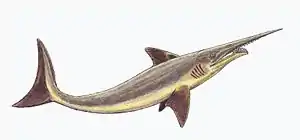Sarcoprion
Sarcoprion (from the Ancient Greek, "flesh saw") is an extinct genus of eugeneodontid holocephalids from the Permian of Greenland. Similar to other eugeneodontids such as Edestus and Helicoprion, it was best known for its extremely bizarre tooth morphology compared to other species of sharks and their closest relatives, the chimaeras. Compared to other members of the Helicoprionidae (teeth of Agassiz), its "tooth whorls" were found to be sharper, more compact, and in better condition than other sharks of the time, and refrained from growing to extremely unwieldy forms that would raise questions about its ability to feed properly.[1] The genus contains one species, Sarcoprion edax, found in Permian-aged marine strata of Meddelelser om Grønland.
| Sarcoprion Temporal range: Wuchiapingian, | |
|---|---|
 | |
| Life restoration of Sarcoprion edax | |
| Scientific classification | |
| Domain: | Eukaryota |
| Kingdom: | Animalia |
| Phylum: | Chordata |
| Class: | Chondrichthyes |
| Order: | †Eugeneodontida |
| Family: | †Helicoprionidae |
| Genus: | †Sarcoprion Nielsen, 1952 |
| Species | |
| |
Description
Sarcoprion had a jaw and mouth structure which allowed it to be more hydrodynamic, reducing the size and shape of the tooth whorl and increasing the size of the rostrum. Estimations on its size suggested an average length of 6 m (20 ft)[2] from the two specimens discovered in Greenland.
References
- http://2dgf.dk/xpdf/bull48-2-159-167.pdf Sarcoprion Nielsen, 1952
- Stanislav Drobyshevsky (2022). Палеонтология антрополога. Книга 1. Докембрий и палеозой (Paleontology of anthropologist. Volume 1. Precambrian and Paleozoic). Eksmo. ISBN 9785042095238. Retrieved 31 August 2022.